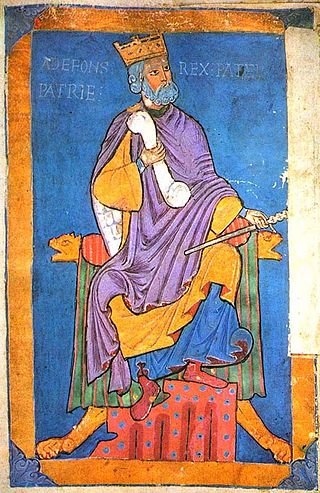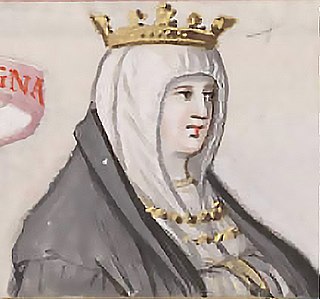
Afonso I, also called Afonso Henriques, nicknamed the Conqueror and the Founder by the Portuguese, was the first king of Portugal. He achieved the independence of the County of Portugal, establishing a new kingdom and doubling its area with the Reconquista, an objective that he pursued until his death.

Ferdinand II, was a member of the Castilian cadet branch of the House of Ivrea and King of León and Galicia from 1157 until his death.

Alfonso VI, nicknamed the Brave or the Valiant, was king of León (1065–1109), Galicia (1071–1109), and Castile (1072–1109).

Ferdinand III, called the Saint, was King of Castile from 1217 and King of León from 1230 as well as King of Galicia from 1231. He was the son of Alfonso IX of León and Berenguela of Castile. Through his second marriage he was also Count of Aumale. Ferdinand III was one of the most successful kings of Castile, securing not only the permanent union of the crowns of Castile and León, but also masterminding the most expansive southward territorial expansion campaign yet in the Guadalquivir Valley, in which Islamic rule was in disarray in the wake of the decline of the Almohad presence in the Iberian Peninsula. He was made a saint in 1671.

Alfonso VII, called the Emperor, became the King of Galicia in 1111 and King of León and Castile in 1126. Alfonso, born Alfonso Raimúndez, first used the title Emperor of All Spain, alongside his mother Urraca, once she vested him with the direct rule of Toledo in 1116. Alfonso later held another investiture in 1135 in a grand ceremony reasserting his claims to the imperial title. He was the son of Urraca of León and Raymond of Burgundy, the first of the House of Ivrea to rule in the Iberian peninsula.

Henry II, called Henry of Trastámara or the Fratricidal, was the first King of Castile and León from the House of Trastámara. He became king in 1369 by defeating his half-brother Peter the Cruel, after numerous rebellions and battles. As king he was involved in the Fernandine Wars and the Hundred Years' War.

The Kingdom of León was an independent kingdom situated in the northwest region of the Iberian Peninsula. It was founded in 910 when the Christian princes of Asturias along the northern coast of the peninsula shifted their capital from Oviedo to the city of León. The kings of León fought civil wars, wars against neighbouring kingdoms, and campaigns to repel invasions by both the Moors and the Vikings, all in order to protect their kingdom's changing fortunes.

Theresa was Countess of Portugal, and for a time claimant to be its independent Queen. She rebelled against her half-sister Queen Urraca of León. She was recognised as Queen by Pope Paschal II in 1116, but was captured and forced to accept Portugal's vassalage to León in 1121, being allowed to keep her royal title. Her political alliance and amorous liaison with Galician nobleman Fernando Pérez de Traba led to her being ousted by her son, Afonso Henriques, who with the support of the Portuguese nobility and clergy, defeated her at the Battle of São Mamede in 1128.

Maria of Portugal was a Portuguese princess who became Queen of Castile upon her marriage to Alfonso XI in 1328. She was the eldest daughter of King Afonso IV of Portugal and his wife Beatrice of Castile.

Henry, Count of Portugal, was the first member of the Capetian House of Burgundy to rule Portugal and the father of the country's first king, Afonso Henriques.

García II, King of Galicia, was the youngest of the three sons and heirs of Ferdinand I, King of Castile and León, and Sancha of León, whose Leonese inheritance included the lands García would be given. Garcia first appears in an 11 September 1064 settlement with Suero, Bishop of Mondoñedo, his father confirming the agreement.

The Santiago de Compostela Arch cathedral Basilica is part of the Metropolitan Archdiocese of Santiago de Compostela and is an integral component of the Santiago de Compostela World Heritage Site in Galicia, Spain. The cathedral is the reputed burial place of Saint James the Great, one of the apostles of Jesus Christ. It is also among the remaining churches in the world built over the tomb of an apostle, the other ones being St Peter's Basilica in Vatican City, St Thomas Cathedral Basilica in Chennai, India and Basilica of St. John in Izmir, Turkey.

Osorio Martínez was a magnate from the Province of León in the Empire of Alfonso VII. He served as the emperor militarily throughout his long career, which peaked in 1138–41. Besides the documentary sources, which are somewhat meagre at times after his fall from royal favour, he is mentioned in two episodes in the Chronica Adefonsi imperatoris. He supported Ferdinand II of León after Alfonso's death (1157), but he died in a Castilian civil war in 1160.

Pedro Fernández de Castro, nicknamed el de la Guerra, was a powerful Galician noble and military figure of the House of Castro, descended by illegitimate lines from the kings of Castile-Leon-Galicia. Pedro Fernandez de Castro was Lord (Señor) of Lemos and Sarria and served as mayordomo mayor of Alfonso XI of Castile, adelantado de la frontera (governor) of Andalusia, Galicia and Murcia and pertiguero mayor of the lands of Santiago.
Sancha Raimúndez of León was a Leonese infanta, the daughter of Queen Urraca and Raymond of Burgundy and the older sister of Alfonso VII of León.

The Pantheon of Asturian Kings is a chapel of Nuestra Señora del Rey Casto in the Cathedral of San Salvador, Oviedo, Spain. It is the burial place of many of the rulers of the medieval kingdoms of Asturias and León.

The Royal Collegiate Church of Saint Hippolytus is a Catholic Church in Córdoba, (Spain) founded in 1343 at the initiative of King Alfonso XI of Castile. The church, which was later granted in perpetuity to the Society of Jesus, contains the tombs of King Ferdinand IV and his son Alfonso XI.

The Castilian House of Ivrea, also known as the House of Burgundy, is a cadet branch of the House of Ivrea descended from Raymond of Burgundy. Raymond married Urraca, the eldest legitimate daughter of Alfonso VI of León and Castile of the House of Jiménez. Two years after Raymond's death, Urraca succeeded her father and became queen of Castile and León; Urraca's and Raymond's offspring in the legitimate line ruled the kingdom from 1126 until the death of Peter of Castile in 1369, while their descendants in an illegitimate line, the House of Trastámara, would rule Castile and Aragón into the 16th century.

Gonzalo Núñez II de Lara, son of Count Nuño Pérez de Lara and Teresa Fernández de Traba, was a high ranking noble (ricohombre) and prominent member of the powerful House of Lara, one of the principals of the kingdoms of León and of Castile. Unlike his older brothers, Fernando and Álvaro, with whom he was in the Battle of Las Navas de Tolosa, most of his life was spent in the kingdom of León.



















